国际金融学章节练习题答案优选稿
国际金融学试题和答案(免费)
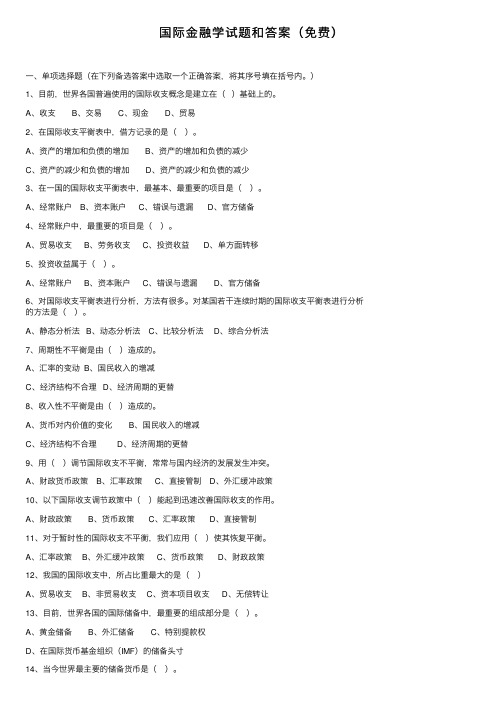
国际⾦融学试题和答案(免费)⼀、单项选择题(在下列备选答案中选取⼀个正确答案,将其序号填在括号内。
)1、⽬前,世界各国普遍使⽤的国际收⽀概念是建⽴在()基础上的。
A、收⽀B、交易C、现⾦D、贸易2、在国际收⽀平衡表中,借⽅记录的是()。
A、资产的增加和负债的增加B、资产的增加和负债的减少C、资产的减少和负债的增加D、资产的减少和负债的减少3、在⼀国的国际收⽀平衡表中,最基本、最重要的项⽬是()。
A、经常账户B、资本账户C、错误与遗漏D、官⽅储备4、经常账户中,最重要的项⽬是()。
A、贸易收⽀B、劳务收⽀C、投资收益D、单⽅⾯转移5、投资收益属于()。
A、经常账户B、资本账户C、错误与遗漏D、官⽅储备6、对国际收⽀平衡表进⾏分析,⽅法有很多。
对某国若⼲连续时期的国际收⽀平衡表进⾏分析的⽅法是()。
A、静态分析法B、动态分析法C、⽐较分析法D、综合分析法7、周期性不平衡是由()造成的。
A、汇率的变动B、国民收⼊的增减C、经济结构不合理D、经济周期的更替8、收⼊性不平衡是由()造成的。
A、货币对内价值的变化B、国民收⼊的增减C、经济结构不合理D、经济周期的更替9、⽤()调节国际收⽀不平衡,常常与国内经济的发展发⽣冲突。
A、财政货币政策B、汇率政策C、直接管制D、外汇缓冲政策10、以下国际收⽀调节政策中()能起到迅速改善国际收⽀的作⽤。
A、财政政策B、货币政策C、汇率政策D、直接管制11、对于暂时性的国际收⽀不平衡,我们应⽤()使其恢复平衡。
A、汇率政策B、外汇缓冲政策C、货币政策D、财政政策12、我国的国际收⽀中,所占⽐重最⼤的是()A、贸易收⽀B、⾮贸易收⽀C、资本项⽬收⽀D、⽆偿转让13、⽬前,世界各国的国际储备中,最重要的组成部分是()。
A、黄⾦储备B、外汇储备C、特别提款权D、在国际货币基⾦组织(IMF)的储备头⼨14、当今世界最主要的储备货币是()。
A、美元B、英镑C、德马克D、法国法郎15、仅限于会员国政府之间和IMF与会员国之间使⽤的储备资产是()。
《国际金融学》习题与答案

《国际金融学》习题答案《国际金融学》习题答案一、简答题1、国际收支平衡表的编制原理是什么?(1)记帐制度——复式簿记原理。
记账规则:有借必有贷,借贷必相等。
入表原则:凡是引起外汇流出的项目记入该项目的借方,凡是引起外汇流入的项目记入该项目的贷方。
(2)交易的记载时间。
IMF建议采用“权责发生制”,即所有权变更原则。
(3)记帐单位,国际收支平衡表一般按外币记载。
(4)定值(Valuation)在可以得到市场价格的情况下,按市场价格对交易定值债务工具大多按面值定值货物出口按离岸价格(FOB)定值来自海关的进口数据是到岸价格(CIF)数据,采用5%的调整系数,以得到离岸价格(FOB)数据。
2、国际收支平衡表的分析方法有哪些?(1)静态分析。
静态分析是对某一国一个时期的国际收支平衡表进行逐项,细致的分析。
包括:贸易差额;劳务差额;经常项目差额;基本差额;国际收支总差额。
(2)动态分析。
动态分析是对某国若干连续时期的国际收支平衡表进行分析。
动态分析实际上是对一国的国际收支进行纵向分析。
(3)比较分析。
比较分析是对不同国家同一时期的国际收支平衡表进行分析比较.将某一国某个时期的国际收支平衡表与其他国家进行对比,可以了解该国的国际经济地位和经济实力。
3、国际收支失衡的主要原因是什么?引起一国国际收支失衡的原因很多,概括起来主要有临时性因素、收入性因素、货币性因素、周期性因素和结构性因素。
(1)临时性失衡。
临时性失衡是指各国短期的、由非确定或偶然因素引起的国际收支失衡。
自然灾害、政局变化等意料之外的因素都可能对国际收支产生重大的影响。
(2)收入性失衡。
收入性失衡是指各国经济增长速度不同所引起的国际收支失衡。
一国国民收入相对快速增长,会导致进口需求的增长,从而使国际收支出现逆差。
(3)货币性失衡。
货币性失衡是指货币供应量的相对变动所引起的国际收支失衡。
一国货币供应量增长较快,会使该国出现较高的通货膨胀,在汇率变动滞后的情况下,国内货币成本上升,出口商品价格相对上升而进口价格相对下降,从而出现国际收支逆差。
完整版)国际金融练习题(含答案
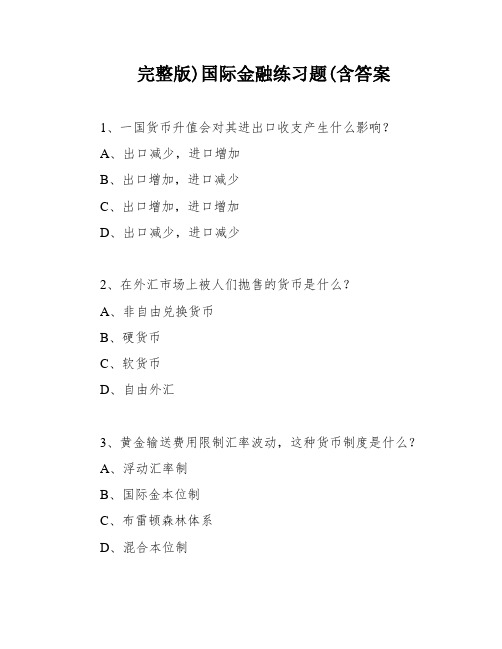
完整版)国际金融练习题(含答案1、一国货币升值会对其进出口收支产生什么影响?A、出口减少,进口增加B、出口增加,进口减少C、出口增加,进口增加D、出口减少,进口减少2、在外汇市场上被人们抛售的货币是什么?A、非自由兑换货币B、硬货币C、软货币D、自由外汇3、黄金输送费用限制汇率波动,这种货币制度是什么?A、浮动汇率制B、国际金本位制C、布雷顿森林体系D、混合本位制4、如果在直接标价的前提下,需要比原来更少的本币才能兑换一定数量的外国货币,这意味着什么?A、本币币值上升,外币币值下降,通常称为外汇汇率上升B、本币币值下降,外币币值上升,通常称为外汇汇率上升C、本币币值上升,外币币值下降,通常称为外汇汇率下降D、本币币值下降,外币币值上升,通常称为外汇汇率下降5、当一国经济出现通货膨胀和顺差时,为了内外经济的平衡,根据财政货币政策配合理论,应采取的措施是什么?A、膨胀性的财政政策和膨胀性的货币政策B、紧缩性的财政政策和紧缩性的货币政策C、膨胀性的财政政策和紧缩性的货币政策D、紧缩性的财政政策和膨胀性的货币政策6、欧洲货币市场是什么?A、经营欧洲货币单位的金融市场B、经营欧洲国家货币的金融市场C、欧洲国家国际金融市场的总称D、经营境外货币的国际金融市场7、国际债券包括什么?A、固定利率债券和浮动利率债券B、外国债券和欧洲债券C、美元债券和日元债券D、欧洲美元债券和欧元债券8、一国国际收支顺差会使什么发生?A、外国对该国货币需求增加,该国货币汇率上升B、外国对该国货币需求减少,该国货币汇率下跌C、外国对该国货币需求增加,该国货币汇率下跌D、外国对该国货币需求减少,该国货币汇率上升9、金本位的特点是什么?A、自由买卖、自由铸造、自由兑换B、自由铸造、自由兑换、自由输出入C、自由买卖、自由铸造、自由输出入D、自由流通、自由兑换、自由输出入10、根据财政政策配合的理论,当一国实施紧缩性的财政政策和货币政策,其目的在于什么?A、克服该国经济的通货膨胀和国际收支逆差B、克服该国经济的衰退和国际收支逆差C、克服该国通货膨胀和国际收支顺差D、克服该国经济衰退和国际收支顺差11、资本流出表示什么?A、外国对本国的负债减少B、本国对外国的负债增加13、目前,我国实行的汇率制度是有管理浮动汇率制。
(完整word版)国际金融习题集答案打印版
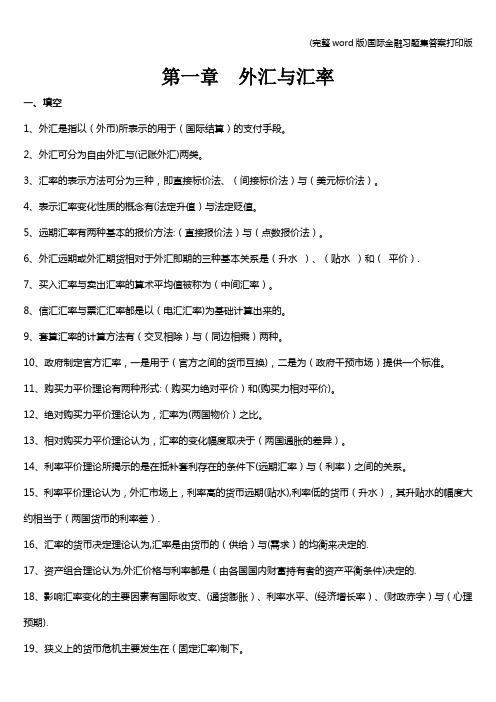
第一章外汇与汇率一、填空1、外汇是指以(外币)所表示的用于(国际结算)的支付手段。
2、外汇可分为自由外汇与(记账外汇)两类。
3、汇率的表示方法可分为三种,即直接标价法、(间接标价法)与(美元标价法)。
4、表示汇率变化性质的概念有(法定升值)与法定贬值。
5、远期汇率有两种基本的报价方法:(直接报价法)与(点数报价法)。
6、外汇远期或外汇期货相对于外汇即期的三种基本关系是(升水)、(贴水)和(平价).7、买入汇率与卖出汇率的算术平均值被称为(中间汇率)。
8、信汇汇率与票汇汇率都是以(电汇汇率)为基础计算出来的。
9、套算汇率的计算方法有(交叉相除)与(同边相乘)两种。
10、政府制定官方汇率,一是用于(官方之间的货币互换),二是为(政府干预市场)提供一个标准。
11、购买力平价理论有两种形式:(购买力绝对平价)和(购买力相对平价)。
12、绝对购买力平价理论认为,汇率为(两国物价)之比。
13、相对购买力平价理论认为,汇率的变化幅度取决于(两国通胀的差异)。
14、利率平价理论所揭示的是在抵补套利存在的条件下(远期汇率)与(利率)之间的关系。
15、利率平价理论认为,外汇市场上,利率高的货币远期(贴水),利率低的货币(升水),其升贴水的幅度大约相当于(两国货币的利率差).16、汇率的货币决定理论认为,汇率是由货币的(供给)与(需求)的均衡来决定的.17、资产组合理论认为,外汇价格与利率都是(由各国国内财富持有者的资产平衡条件)决定的.18、影响汇率变化的主要因素有国际收支、(通货膨胀)、利率水平、(经济增长率)、(财政赤字)与(心理预期).19、狭义上的货币危机主要发生在(固定汇率)制下。
20、货币危机按其性质不同,可分为(经济条件恶化所造成的货币危机)与(心理预期所导致的货币危机).21、货币危机最容易传播到以下三类国家:一是(与货币危机发生国有较密切的贸易关系或出口上存在竞争关系)的国家、二是(与货币危机发生国存在较为相近的经济结构、发展模式及潜在经济问题)的国家、三是过分依赖国外资金流入的国家。
国际金融学知到章节答案智慧树2023年哈尔滨金融学院

国际金融学知到章节测试答案智慧树2023年最新哈尔滨金融学院第一章测试1.某日外汇市场行情为USD/JPY:120.10/120.20,EUR/USD:1.1005/1.1015,求EUR/JPY为()。
参考答案:132.17/132.402.银行挂牌的卖出汇率是()的价格。
参考答案:银行卖出外汇;顾客买入外3.一国货币对外贬值,一般()。
参考答案:不利于进口;有利于出口4.我国于2008年8月1日修订的《中华人民共和国外汇管理条例》规定,外汇是()。
参考答案:其他外汇资产;特别提款权、欧洲货币单位;外币有价证券,包括政府债券、公司债券、股票等;外国货币,包括纸币、铸币;外汇支付凭证,包括票据、银行存款凭证、银行卡等5.一种外币成为外汇的前提条件主要包括()。
参考答案:可接受性;自由兑换性;可偿性第二章测试1.属于外汇管制中直接管制方法的是()。
参考答案:行政审批制度2.属于建立社会主义市场经济以来的中国外汇管理体制的内容()。
参考答案:实行银行结售汇制度;汇率并轨,实行以市场供求为基础的.单一的.有管理的浮动汇率制度;对外商投资企业外汇管理政策保持不变;建立统一的.规范化的.有效率的外汇市场3.国际货币体系的主要任务在于促进世界经济的发展和稳定,促进各国经济的平衡发展。
()参考答案:对4.国际货币体系是指为了适应国际贸易和国际支付的需要,使货币在国际范围内发挥支付职能,各国政府都共同遵守的有关政策规定和制度安排。
()参考答案:错5.国际金本位制是指以黄金作为本位货币,并建立起流通中各种货币与黄金间固定兑换关系的货币制度。
()参考答案:对6.金块本位制下国家无需规定货币的含金量,市场上不再流通金币,只流通银行券。
()参考答案:错7.牙买加体系是以美元为中心的国际储备多元化的浮动汇率体系。
()参考答案:对8.经济转型时期的中国外汇管理体制实行的是银行结售汇制度。
()参考答案:错9.浮动汇率制度与固定汇率制度的选择因素。
国际金融第一章习题及参考答案

第一章习题一、名词解释1、国际收支2、资本账户3、自主性交易4、综合账户差额5、货币性失衡二、填空1、国际收支平衡表就是国际收支按特定账户分类和记账原则表示出来的。
其任何一笔交易的发生,必然涉及和两个方面。
2、国际收支平衡表中的所有账户可分为三大类:即、和。
3、在国际收支平衡表中,当收入大于支出时,我们称之为;反之当支出大于收入时,我们称之为。
4、补偿性交易,是指为而发生的交易。
5、考察国际收支在性质上是否平衡的四个口径,分别是、、和。
三、单项选择1、是指一国在一定日期(如某年某月某日)对外债权债务的综合情况。
A、国际收支B、国际借贷C、贸易收支D、资本收支2、下列四项中不属于经常项目A 旅游收支B 侨民汇款C 通讯运输D 直接投资3、下列项目应记入贷方的是A. 反映进口实际资源的经常项目B. 反映出口实际资源的经常项目C. 反映资产增加或负债减少的金融项目D. 反映资产减少或负债增加的金融项目4、若在国际收支平衡表,储备资产项目为-100亿美元,则表示该国A. 增加了100亿美元的储备B. 减少了100亿美元的储备C. 人为的账面平衡,不说明问题D. 无法判断5、股息、红利等投资收益属于A、劳务收支B、贸易收支C、转移收支D、资本项目6、在经济繁荣时期,由于国内需求旺盛,进出口业务会发生相应的变动,则国际收支可能出现。
A、顺差B、逆差C、平衡D、不确定7、只有才能在总体上反映一国自主性交易的状况。
A、经常项目B、资本项目C、贸易收支D、官方结算8、游资(Hot Money)应计入项目。
A、长期资本B、短期资本C、经常项目D、资本项目四、多项选择1、属于国际收支经常转移的项目有A.劳务收入B.侨汇C.无偿捐赠D.赔偿2、下列项目应记入贷方的是A、基本帐户资产增加B、储备帐户资产增加C、基本帐户负债增加D、储备帐户负债增加E、基本帐户收入增加F、储备帐户收入增加3、导致国际收支失衡的经济结构原因包括A.外汇投机B.产品供求结构失衡C.自然灾害D.要素价格失衡4、国际收支的“储备与相关项目”包括A.储备资产B.使用IMF贷款C.国外融资D.对外国官方负债5、关于资本账户,下列说法正确的是A.借方记录资本流出,贷方记录资本流入B.借方记录资本流人,贷方记录资本流出C.资本账户的各个项目是按照净额来记入借方或贷方的D.资本账户的各个项目不按照净额来记入借方或贷方的6、关于国际收支的平衡,下列说法正确的是A.自主性交易所产生的货币收支并不必定相抵B.补偿性交易是为了弥补自主性交易收支不平衡的融通性交易C.国际收支差额本质上是一个会计概念D.实际上并不存在某种单一的尺度能用来衡量一国国际收支是否平衡五、判断题1、国际收支是一个流量的、事后的概念。
国际金融习题以及答案.doc
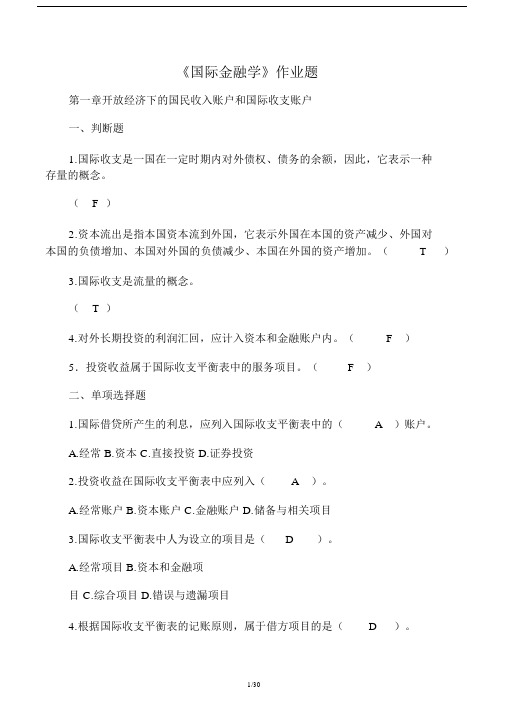
《国际金融学》作业题第一章开放经济下的国民收入账户和国际收支账户一、判断题1.国际收支是一国在一定时期内对外债权、债务的余额,因此,它表示一种存量的概念。
( F )2.资本流出是指本国资本流到外国,它表示外国在本国的资产减少、外国对本国的负债增加、本国对外国的负债减少、本国在外国的资产增加。
(T)3.国际收支是流量的概念。
(T )4.对外长期投资的利润汇回,应计入资本和金融账户内。
(F)5.投资收益属于国际收支平衡表中的服务项目。
(F)二、单项选择题1.国际借贷所产生的利息,应列入国际收支平衡表中的(A)账户。
A.经常B.资本C.直接投资D.证券投资2.投资收益在国际收支平衡表中应列入(A)。
A.经常账户B.资本账户C.金融账户D.储备与相关项目3.国际收支平衡表中人为设立的项目是(D)。
A.经常项目B.资本和金融项目 C.综合项目 D.错误与遗漏项目4.根据国际收支平衡表的记账原则,属于借方项目的是(D)。
A.出口商品B.官方储备的减少C.本国居民收到国外的单方向转移 D.本国居民偿还非居民债务。
5.根据国际收入平衡表的记账原则,属于贷方项目的是(B)。
A.进口劳务B.本国居民获得 xx 资产C.官方储备增加D.非居民偿还本国居民债务三、多项选择题1.属于我国居民的机构是(ABC)。
A.在我国建立的外商独资企业B.我国的国有企业C.我国驻外使领馆D. IMF等驻华机构2.国际收支平衡表中的经常账户包括( ABCD )子项目。
A.货物 B.服务C.收益 D.经常转移3.国际收支平衡表中的资本与金融账户包括(AB)子项目。
A.资本账户B.金融账户C.服务D.收益4.下列(AD)交易应记入国际收支平衡表的贷方。
A.出口B.进口C.本国对外国的直接投资D.本国居民收到外国侨民汇款5.下列属于直接投资的是(BCD )。
A.美国一家公司拥有一日本企业8%的股权B.青岛海尔在海外设立子公司C.天津摩托罗拉将在中国进行再投资D.麦当劳在中国开连锁店四、名词解释国内吸收、国际投资头寸、国际收支、经常账户、资本与金融账户五、论述题试根据本章的基本原理,对2010 年中国国际收支账户进行简要分析。
第一章国际金融练习与答案(可编辑修改word版)

5.如果你以电话向中国银行询问英镑/美元(英镑兑美元,斜线“/”表示“兑”)的汇价。
中国银行答道:“1.6900/10”。
请问:(1)中国银行以什么汇价向你买进美元?(2)你以什么汇价从中国银行买进英镑?(3)如果你向中国银行卖出英镑,汇率是多少?5、解:银行买入1 英镑,支付客户(卖出)1.6900 美元③银行卖出1 英镑,收取客户(买入)1.6910 美元①②6.某银行询问美元兑新加坡元的汇价,你答复道:“1美元=1.6403/1.6410”。
请问:如果该银行想把美元卖给你,汇率是多少?6、解:你(卖方)买入1 美元,支付银行1.6403S$★银行卖出1 美元,收取银行 1.6403S$ ★你(卖方)卖出1 美元,收取银行1.6410S$ 银行买入1 美元,支付客户1.6410S$ 7.某银行询问美元兑港元汇价,你答复道:“1 美元=7.8000/10 港元”,请问:(1)该银行要向你买进美元,汇价是多少?(2)如你要买进美元,应按什么汇率计算?(3)如你要买进港元,又是什么汇率?7、解:你(卖方)买入1 美元,支付银行7.8000HKD②银行卖出1 美元,收取客户7.8000HKD你(卖方)卖出1 美元,收取银行7.8010HKD③银行买入1 美元,支付客户7.8010HKD①8、如果你是ABC 银行的交易员,客户向你询问澳元/美元汇价,你答复道:“0.7685/90”。
请问:(1)如果客户想把澳元卖给你,汇率是多少?(2)如果客户要买进澳元,汇率又是多少?银行买入1 澳元,支付客户0.7685 美8、解:元(客户卖出1 澳元,收取客户0.7685美元)①银行卖出1 澳元,收取客户0.7690美元(客户买入1 澳元,支付客户0.7690美元)②9、如果你向中国银行询问美元/欧元的报价,回答是:“1.2940/60”。
请问:(1)中国银行以什么汇价向你买入美元,卖出欧元?(2)如果你要买进美元,中国银行给你什么汇率?(3)如果你要买进欧元,汇率又是多少?9、解:银行买入1 美元,支付客户1.2940∈①(客户卖出1 美元,收取客户1.2940∈)③银行卖出1 美元,收取客户1.2960∈(客户买入1 美元,支付银行1.2960∈)②10、如果你是银行,客户向你询问美元兑瑞士法郎汇价,你答复道:“1.4100/10”。
国际金融学知到章节答案智慧树2023年湖北经济学院

国际金融学知到章节测试答案智慧树2023年最新湖北经济学院绪论单元测试1.国际金融学的研究内容既包括宏观层面的内容,也包括微观层面的内容。
参考答案:对第一章测试1.国际收支全面反映一国的对外()参考答案:经济关系2.国际收支是一个()参考答案:流量概念3.国际收支平衡表进行统计记录的记帐原理是()参考答案:复式记账4.在国际收支平衡表中,投资收益被记入()参考答案:经常项目5.记入国际收支平衡表贷方的交易有()参考答案:出口;资本流入第二章测试1.外国企业在美国发行的美元债券被称为()参考答案:扬基债券2.中国中信集团在新加坡市场发行的,以美元标明面值的债券属于()参考答案:欧洲债券3.金融创新的根本目的是()。
参考答案:控制风险;规避金融监管;提高金融效率;增加盈利4.交易双方进行利率互换需要进行本金交换。
()参考答案:错5.信用违约互换需要转移基础信用资产。
()参考答案:错第三章测试1.外汇现钞使用起来更方便,所以外汇现钞比外汇现汇的汇价要更便宜()参考答案:错2.按照交易的期限划分,外汇市场可分为()参考答案:即期外汇市场和远期外汇市场3.双边市场套汇是在()交易中进行的参考答案:即期外汇4.在即期外汇交易中,资金的实际交割时间可以是()参考答案:成交的当日;成交后的第二个营业日;成交后的第一个营业日5.某日纽约USD1=HKD7.7820—7.7830,伦敦 GBP1=USD 1.5140—1.5150,问:英镑与港元的汇率是多少?()参考答案:{ GBP1=HKD 11.7819—11.7912}第四章测试1.一国货币当局按照本国经济利益的需要,对外汇市场进行直接或间接的干预,以使本国货币汇率向有利于本国的方向浮动的汇率制度是()参考答案:管理浮动汇率制2.外汇管制的方法和措施主要有:()参考答案:对汇率的管制;对外汇资金的管制;对黄金、现钞的管制;对货币兑换的管制3.在何种汇率制度下,官方不必持有外汇储备()参考答案:自由浮动汇率制度4.自由浮动又称清洁浮动,这种汇率制度的灵活性最大,目前实行浮动汇率制度的国家大都属于这种汇率制度()参考答案:错5.在金本位制下,汇率的波动界限大致是黄金输送点。
国际金融学习题及答案(DOC)
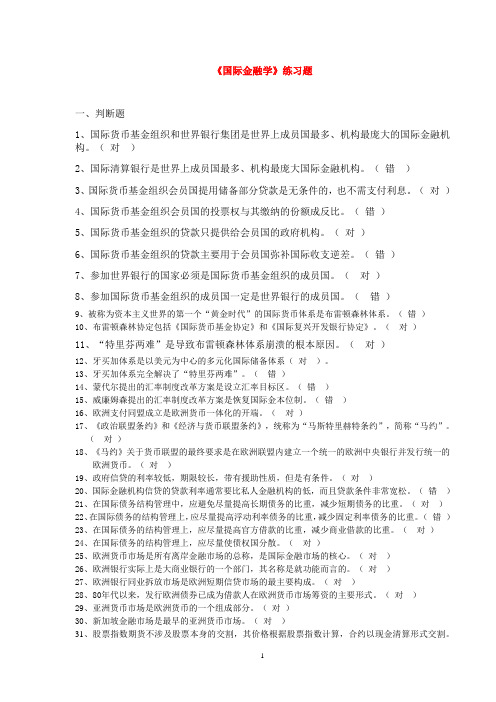
《国际金融学》练习题一、判断题1、国际货币基金组织和世界银行集团是世界上成员国最多、机构最庞大的国际金融机构。
(对)2、国际清算银行是世界上成员国最多、机构最庞大国际金融机构。
(错)3、国际货币基金组织会员国提用储备部分贷款是无条件的,也不需支付利息。
(对)4、国际货币基金组织会员国的投票权与其缴纳的份额成反比。
(错)5、国际货币基金组织的贷款只提供给会员国的政府机构。
(对)6、国际货币基金组织的贷款主要用于会员国弥补国际收支逆差。
(错)7、参加世界银行的国家必须是国际货币基金组织的成员国。
(对)8、参加国际货币基金组织的成员国一定是世界银行的成员国。
(错)9、被称为资本主义世界的第一个“黄金时代”的国际货币体系是布雷顿森林体系。
(错)10、布雷顿森林协定包括《国际货币基金协定》和《国际复兴开发银行协定》。
(对)11、“特里芬两难”是导致布雷顿森林体系崩溃的根本原因。
(对)12、牙买加体系是以美元为中心的多元化国际储备体系(对)。
13、牙买加体系完全解决了“特里芬两难”。
(错)14、蒙代尔提出的汇率制度改革方案是设立汇率目标区。
(错)15、威廉姆森提出的汇率制度改革方案是恢复国际金本位制。
(错)16、欧洲支付同盟成立是欧洲货币一体化的开端。
(对)17、《政治联盟条约》和《经济与货币联盟条约》,统称为“马斯特里赫特条约”,简称“马约”。
(对)18、《马约》关于货币联盟的最终要求是在欧洲联盟内建立一个统一的欧洲中央银行并发行统一的欧洲货币。
(对)19、政府信贷的利率较低,期限较长,带有援助性质,但是有条件。
(对)20、国际金融机构信贷的贷款利率通常要比私人金融机构的低,而且贷款条件非常宽松。
(错)21、在国际债务结构管理中,应避免尽量提高长期债务的比重,减少短期债务的比重。
(对)22、在国际债务的结构管理上,应尽量提高浮动利率债务的比重,减少固定利率债务的比重。
(错)23、在国际债务的结构管理上,应尽量提高官方借款的比重,减少商业借款的比重。
(完整版)国际金融学章节练习题答案
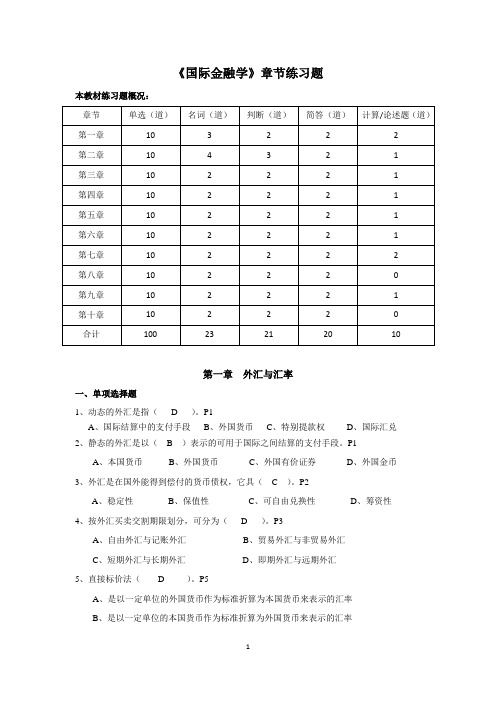
《国际金融学》章节练习题本教材练习题概况:第一章外汇与汇率一、单项选择题1、动态的外汇是指( D )。
P1A、国际结算中的支付手段B、外国货币C、特别提款权D、国际汇兑2、静态的外汇是以( B )表示的可用于国际之间结算的支付手段。
P1A、本国货币B、外国货币C、外国有价证券D、外国金币3、外汇是在国外能得到偿付的货币债权,它具( C )。
P2A、稳定性B、保值性C、可自由兑换性D、筹资性4、按外汇买卖交割期限划分,可分为( D )。
P3A、自由外汇与记账外汇B、贸易外汇与非贸易外汇C、短期外汇与长期外汇D、即期外汇与远期外汇5、直接标价法( D )。
P5A、是以一定单位的外国货币作为标准折算为本国货币来表示的汇率B、是以一定单位的本国货币作为标准折算为外国货币来表示的汇率C、是以美元为标准来表示各国货币的价格D、是以一定单位的本国货币作为标准折算为一定数额的外国货币来表示的汇率6、若某日外汇市场上A银行报价如下:美元/日元:119.73欧元/美元:1.1938Z先生要向A银行购入1欧元,要支付多少日元( A )?P5A、142.9337B、143.7956C、100.0251D、100.62827、若某日外汇市场上A银行报价如下:美元/日元:119.73/120.13美元/加元:1.1490/1.1530Z先生要向A银行卖出10000日元,能获得多少加元( D )?P5A、72.69B、72.20C、96.30D、95.658、金本位制下汇率的决定基础是( B )。
P9A、金平价B、铸币平价C、绝对购买力平价D、相对购买力平价9、利率对汇率的变动影响有( C )。
P12A、利率上升,本国汇率上升B、利率下降,本国汇率下降A、需比较国外汇率及本国的通货膨胀率而定D、无法确定10、人民币自由兑换的含义是( A )。
P17A、经常项目的交易中实现的人民币自由兑换B、资本项目的交易中实现的人民币自由兑换C、国内公民个人实现的人民币自由兑换D、经常项目和资本项目下都实现的人民币自由兑换二、名词解释题1、固定汇率:是指一国货币对另一国货币的汇率基本固定,同时将汇率的变动幅度限制在一个规定的较小范围内。
《国际金融》的习题及答案
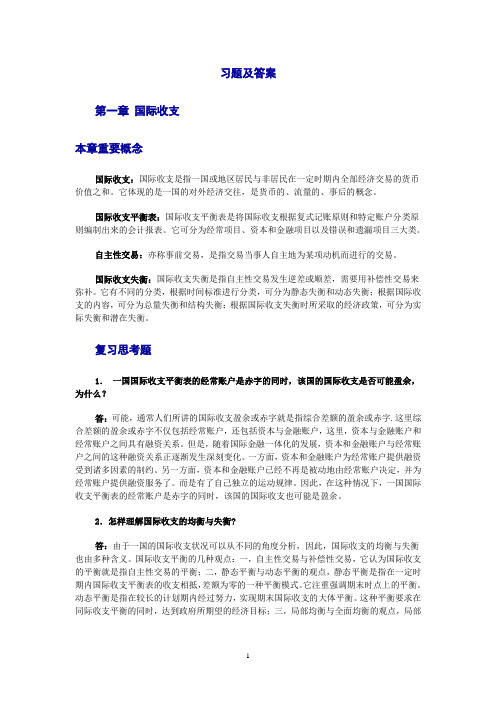
习题及答案第一章国际收支本章重要概念国际收支:国际收支是指一国或地区居民与非居民在一定时期内全部经济交易的货币价值之和。
它体现的是一国的对外经济交往,是货币的、流量的、事后的概念。
国际收支平衡表:国际收支平衡表是将国际收支根据复式记账原则和特定账户分类原则编制出来的会计报表。
它可分为经常项目、资本和金融项目以及错误和遗漏项目三大类。
自主性交易:亦称事前交易,是指交易当事人自主地为某项动机而进行的交易。
国际收支失衡:国际收支失衡是指自主性交易发生逆差或顺差,需要用补偿性交易来弥补。
它有不同的分类,根据时间标准进行分类,可分为静态失衡和动态失衡;根据国际收支的内容,可分为总量失衡和结构失衡;根据国际收支失衡时所采取的经济政策,可分为实际失衡和潜在失衡。
复习思考题1.一国国际收支平衡表的经常账户是赤字的同时,该国的国际收支是否可能盈余,为什么?答:可能,通常人们所讲的国际收支盈余或赤字就是指综合差额的盈余或赤字.这里综合差额的盈余或赤字不仅包括经常账户,还包括资本与金融账户,这里,资本与金融账户和经常账户之间具有融资关系。
但是,随着国际金融一体化的发展,资本和金融账户与经常账户之间的这种融资关系正逐渐发生深刻变化。
一方面,资本和金融账户为经常账户提供融资受到诸多因素的制约。
另一方面,资本和金融账户已经不再是被动地由经常账户决定,并为经常账户提供融资服务了。
而是有了自己独立的运动规律。
因此,在这种情况下,一国国际收支平衡表的经常账户是赤字的同时,该国的国际收支也可能是盈余。
2.怎样理解国际收支的均衡与失衡?答:由于一国的国际收支状况可以从不同的角度分析,因此,国际收支的均衡与失衡也由多种含义。
国际收支平衡的几种观点:一,自主性交易与补偿性交易,它认为国际收支的平衡就是指自主性交易的平衡;二,静态平衡与动态平衡的观点,静态平衡是指在一定时期内国际收支平衡表的收支相抵,差额为零的一种平衡模式。
它注重强调期末时点上的平衡。
国际金融学试题和答案免费word精品文档13页
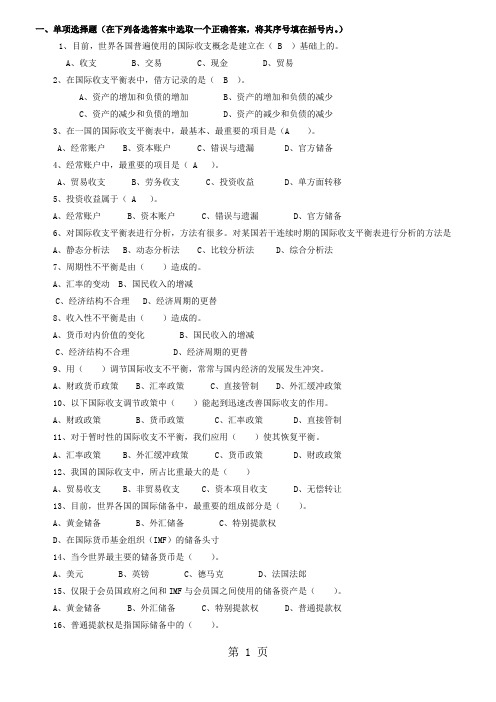
一、单项选择题(在下列备选答案中选取一个正确答案,将其序号填在括号内。
)1、目前,世界各国普遍使用的国际收支概念是建立在( B )基础上的。
A、收支B、交易C、现金D、贸易2、在国际收支平衡表中,借方记录的是( B )。
A、资产的增加和负债的增加B、资产的增加和负债的减少C、资产的减少和负债的增加D、资产的减少和负债的减少3、在一国的国际收支平衡表中,最基本、最重要的项目是(A )。
A、经常账户B、资本账户C、错误与遗漏D、官方储备4、经常账户中,最重要的项目是( A )。
A、贸易收支B、劳务收支C、投资收益D、单方面转移5、投资收益属于( A )。
A、经常账户B、资本账户C、错误与遗漏D、官方储备6、对国际收支平衡表进行分析,方法有很多。
对某国若干连续时期的国际收支平衡表进行分析的方法是A、静态分析法B、动态分析法C、比较分析法D、综合分析法7、周期性不平衡是由()造成的。
A、汇率的变动B、国民收入的增减C、经济结构不合理D、经济周期的更替8、收入性不平衡是由()造成的。
A、货币对内价值的变化B、国民收入的增减C、经济结构不合理D、经济周期的更替9、用()调节国际收支不平衡,常常与国内经济的发展发生冲突。
A、财政货币政策B、汇率政策C、直接管制D、外汇缓冲政策10、以下国际收支调节政策中()能起到迅速改善国际收支的作用。
A、财政政策B、货币政策C、汇率政策D、直接管制11、对于暂时性的国际收支不平衡,我们应用()使其恢复平衡。
A、汇率政策B、外汇缓冲政策C、货币政策D、财政政策12、我国的国际收支中,所占比重最大的是()A、贸易收支B、非贸易收支C、资本项目收支D、无偿转让13、目前,世界各国的国际储备中,最重要的组成部分是()。
A、黄金储备B、外汇储备C、特别提款权D、在国际货币基金组织(IMF)的储备头寸14、当今世界最主要的储备货币是()。
A、美元B、英镑C、德马克D、法国法郎15、仅限于会员国政府之间和IMF与会员国之间使用的储备资产是()。
国际金融课程经典习题与答案

第一部分外汇与汇率一、单顶选择题1.我们通常所说的外汇,是指外汇的()。
A.动态广义概念B.动态狭义概念C。
静态广义概念D.静态狭义概念2.我国《外汇管理条例》中规定的外汇是()。
A动态广义概念B.动态狭义概念C静态广义概念D.静态狭义概念3.以下不属于通常所说的外汇的是()。
A以外币表示的银行汇票B.以外币表示的有价证券C。
以外币表示的支票D。
以外币表示的银行存款4.我国公布的外汇牌价为100美元等于811. 50元人民币,这种标价方法属于()。
A。
直接标价法B。
间接标价法C。
美元标价法D.无法判断5.以间接标价法表示的外汇汇率的升降与本国货币对外价值的高低成()。
A。
正比B.反比C.无关D。
以上说法都不对6.被称为“应收标价法”的是()。
A。
直接标价法 B .间接标价法C.美元标价法D.多重标价法7.我国外汇交易中心每天报出人民币对四种货币的汇率,这些汇率为()。
A.开盘汇率B。
收盘汇率C。
基本汇率D。
套算汇率8.一国通常选定一种在本国对外经济交往中最常用的主要货币,制定出本国货币与它之间的汇率,这就是()。
A。
开盘汇率B。
收盘汇率C。
基本汇率 D.套算汇率9.目前,大多数国家都把本国货币与()的汇率作为基本汇率。
A.美元B.欧元C。
英镑D日元10.如果客户向银行购买外汇,应该使用银行所报出的()。
A.即期汇率B。
中间汇率C。
买人汇率D。
卖出汇率11.采用双向报价时,间接标价法下前一数字为()。
A。
买人价B.卖出价C。
中间价D.现钞价12.外汇汇率最贵的是()。
A.电汇汇率B。
信汇汇率C.票汇汇率D.现钞汇率13.目前,在外汇市场上,已经成为确定计算其他各种汇率基础的汇率是()。
A.电汇汇率B.信汇汇率C。
实际汇率D。
有效汇率14.名义汇率经过通货膨胀因素调整以后的汇率被称为()。
A。
有效汇率B。
实际汇率C。
基本汇率 D.汇率指数15.影响汇率变动的根本原因在于该国的()。
A通货膨胀水平B。
国际金融学习题集答案

国际金融学习题集答案第一章国际收支参考答案:一、单项选择题1.D2.A3.D4.C5.C6.B7.C8.C9.D 10.A 11.D 12.A 13.D14.A 15.D 16.C 17.D 18.B 19.C 20.B 21.D 22.D 23.A 24.D 25.D26.C 27.B 28.B 29.B 30.C 31.A 32.D 33.D 34.D 35. A 36.D 37.D38.D 39.A二、多项选择题1. ACD2.ABCD3.ABCD4.ABCD5.CD6.BC7.ACD8.ACD9.ABD 10.CD11.AB 12.ABCD 13.AD 14.AC 15.AD 16.ABCD 17.ABC 18. AB 19.BD 20.ABCD21.ABCD三、判断题 1.正确2.正确 3.错误4. 错误5. 错误6.正确7.错误8.错误9.正确10.错误11.错误12.错误13.错误14.正确15.正确16.正确17.正确18.正确19.正确20.错误21.错误22.正确23.错误24.错误25.错误26.正确27.正确28.错误29.错误30.正确第二章国际收支调节参考答案一、单项选择题1.A2.A3.A4.B5.B6.B7.C8.A9.A 10.A 11.B 12.B 13.B 14.C 15.A 16.C17.D 18.A 19.B 20.C 21.A 22.B 23.B 24.A 25.D 26.B 27.C二、多项选择题1.ABCD2.ABC3.ABCD4.AC5.ABC6.ABCD7.BD8.AC9.ABC10.ABC11.CD 12.ABC 13.AC 14.ABCD 15.ABCD 16.ABCD 17.AD 18.ACD 19.ABCD 20.AC 21.BD 22.AD 23.AB 24.AD 25.AC三、判断题1.错误2.错误3.错误4. 正确5. 错误6. 正确7. 正确8. 错误9. 正确10. 错误11.错误12. 错误13. 错误14. 正确15. 正确16正确17.错误18. 错误19.正确20. 错误21. 错误22. 错误23. 错误24. 错误25. 错误26. 正确27.错误28. 错误29. 错误30.正确31. 正确32. 错误33. 错误34.正确35.正确第三章外汇和汇率参考答案一、单项选择题1.C2.A3.B4.D5.D6.C7.B8.D9.B 10.B 11.B 12.B 13.A 14.A 15.C 16.C 17.A 18.C 19.A 20.A 21.C 22.B 23.C 24.C 25.C 26.A 27.A 28.A 29.A 30.A 31.A 32.B 33.A34.A 35.B 36.A 37.A 38. C 39.A二、多项选择题1.ABCD2.AC3.BCD4.ABCD5.ABC6.CD7.AC8.ACD9.ACD 10.AD 11.ABCD 12.AD 13.AB 14.AB 15.ACD 16.AC 17.BD 18.ABCD 19.ABC 20.ABCD 21.ABCD 22.BC 23.ABCD三、判断题1. 错误2. 错误3. 错误4. 错误5. 错误6. 错误7. 正确8. 错误9. 正确10. 错误11. 正确12. 正确13.错误14.正确15.正确16.正确17.正确18.正确19.错误20. 正确21. 正确22. 正确23. 正确24. 正确25. 正确26. 正确27. 正确28. 正确29. 正确30. 正确31. 正确32. 正确33. 正确第四章汇率预测与风险管理参考答案一、单项选择题1. A2. B3. C4. A5. C6. B7. A8. A9. B 10. A二、多项选择题1.AC2. CDE3.ABCD4.ABD5.ABCD6.AB7.ABCD8.ABC9.ABC 10.ABC 11.ABC 12.AB 13.BC 14.ABC 15.AB 16.ABCD三、判断题1. 错误2正确3. 正确4. 正确5. 正确 6.正确 7.正确 8.正确 9.正确10.错误11.错误12.正确13.正确14. 正确15.正确16. 错误17. 正确18. 正确19. 正确20正确21.正确22. 错误第五章汇率制度与汇率决定参考答案一、单项选择题1.A2.B3.D4.B5.C6.A7.A8.A9.B 10.B 11.C 12.C13. B 14.C 15.A 16.B 17.A 18.B19.A 20.C 21.C 22.D 23.A二、多项选择题1.ABCD2.CD3.ABCD4.ABC5.ABCD6.ABCD7.ACD8.AC9. ABC 10.AB 11.AC 12.AB 13.ABCD 14.ABCD 15.ABCD 16.AB 17.ABCD18.A C 19.ABC 20.ABC 21.ABC 22.AB 23.ABC 24.AC25.ABCD三、判断题1.正确2.错误3.正确4.正确5.正确6.正确7.正确8.错误9.正确10.正确11.正确12.正确13.正确14.正确15.正确16.正确17. 正确18.正确19.正确20.正确21.正确22.正确23.正确24.正确25.错误26.正确27.错误28.错误29.正确30.错误31.正确32.正确33.错误34.正确35.错误36.错误37.正确38.正确39.错误40.错误41.正确42.错误43.正确44.错误45.正确46.错误47.正确48.错误49.正确50.错误51.正确52.正确53.错误54.正确55.错误56.正确第六章国际投资头寸与国际资金流动参考答案一、单项选择题1.A2. C3. A4. A5.D6.D7.B8.A9.C 10.D 11.D 12.D二、多项选择题1.ABCD2.ABC3.BC4.ABCD5. ABC6.ABC7.ABCD8.ABCD9.ABCD 10.ABCD 11.ABCD 12.AB 13.ABCD 14.ABCD 15.ABCD 16.ABCD 17.ABCD 18.ABCD 19.ABCD 20.ABCD 21. ABCD 22.ABCD 23.ABCD 24.ABCD 25.ABCD 26. ABCD 27.ABCD 28. ABCD 29. ABCD 30.ABCD 31. ABCD 32.CD33.ABC 34.CD 35.ABCD三、判断题1.正确2. 正确3. 错误4.错误5.正确6.正确7.正确8.正确9.正确10.正确11.正确12.正确13.正确14.正确15.错误16.错误17.错误18.正确19.正确20.错误21.错误22.错误第七章国际储备及其管理参考答案一、单项选择题1.A2.C3.A4.D5.A6.B7.A8.D9.B 10.A 11.C 12.C 13.B 14.B 15.B 16.D二、多项选择题1.ABCD2.ABD3.ACD4.ABC5.AB6.ABCD7.AB8.ABCD9.ABD 10.AB 11.ABC 12.A B C13.A B C14.A B C D15.A B C D16.A C D17.A B C D18.A B C19.ABCD 20.AB 21.ABCD22.AB 23.AB 24.CD 25.AB 26.CD 27.ABC三、判断题1.正确2.正确3.正确4.正确5.错误6.正确7.正确8.正确9.错误10.错误 11.正确 12.错误 13.错误 14.正确 15.正确 16.正确 17.错误18.正确 19.错误 20.正确 21.正确 22.正确 23.错误 24. 错误25.错误26.错误 27.错误第八章国际金融危机参考答案一、单项选择题1.B2.D3.B4.D5.C6.B7.D8.C9.A 10.C 11.A 12.B二、多项选择题1.ABCD2.ABC3.ABCD4.ABC5.ABCD6.ABCD7.ABCD8.ABCD9.ABCD 10.ABCD 11.ABCD 12.ABC 13.ABC 14.ABCD 15.ABCD 16.ABCD三、判断题1.正确2.正确3.错误4.正确5. 正确6.正确7.正确8.正确9.正确 10.错误 11.正确12.正确 13.正确 14.错误 15.正确 16.错误第九章国际货币体系参考答案一、单项选择题1.A2. B3.A4.B5.A6.A7.B8.B9.C 10.A 11.C二、多项选择题1.ABCD2.ABC3.BCD4.AB5.ABC6.ABCD7.AB8.ABCD9.ACD 10.ABCD 11.ABC 12.ABCD 13.ABCD 14.ABCD 15.ABCD 16.BCD 17.ABCD 18.ABCD19.ABCD 20.ABC三、判断题1.正确2.正确3.正确4.正确5.错误6.正确7.错误8.错误9.错误10.正确11.正确12.正确13.正确14.正确15.正确。
国际金融学试题和答案.doc
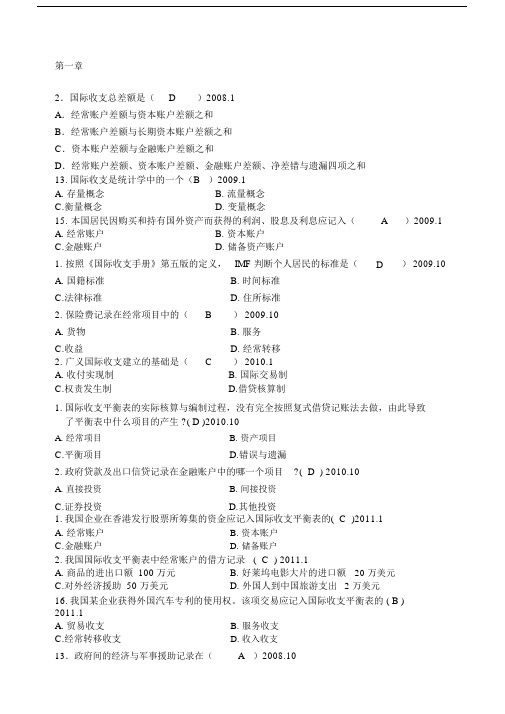
第一章2.国际收支总差额是(D)2008.1A.经常账户差额与资本账户差额之和B.经常账户差额与长期资本账户差额之和C.资本账户差额与金融账户差额之和D.经常账户差额、资本账户差额、金融账户差额、净差错与遗漏四项之和13.国际收支是统计学中的一个(B )2009.1A. 存量概念B. 流量概念C.衡量概念D. 变量概念15. 本国居民因购买和持有国外资产而获得的利润、股息及利息应记入( A )2009.1A. 经常账户B. 资本账户C.金融账户D. 储备资产账户1. 按照《国际收支手册》第五版的定义, IMF 判断个人居民的标准是( D ) 2009.10A. 国籍标准B. 时间标准C.法律标准D. 住所标准2. 保险费记录在经常项目中的( B ) 2009.10A. 货物B. 服务C.收益D. 经常转移2. 广义国际收支建立的基础是( C ) 2010.1A. 收付实现制B. 国际交易制C.权责发生制D.借贷核算制1.国际收支平衡表的实际核算与编制过程,没有完全按照复式借贷记账法去做,由此导致了平衡表中什么项目的产生 ?( D )2010.10A. 经常项目B. 资产项目C.平衡项目D.错误与遗漏2.政府贷款及出口信贷记录在金融账户中的哪一个项目 ?( D ) 2010.10A. 直接投资B. 间接投资C.证券投资D.其他投资1.我国企业在香港发行股票所筹集的资金应记入国际收支平衡表的( C )2011.1A. 经常账户B. 资本账户C.金融账户D. 储备账户2.我国国际收支平衡表中经常账户的借方记录 ( C ) 2011.1A. 商品的进出口额100 万元B. 好莱坞电影大片的进口额20 万美元C.对外经济援助 50 万美元D. 外国人到中国旅游支出 2 万美元16.我国某企业获得外国汽车专利的使用权。
该项交易应记入国际收支平衡表的 ( B )2011.1A. 贸易收支C.经常转移收支B. 服务收支D. 收入收支13.政府间的经济与军事援助记录在(A)2008.10A.经常账户B.资本账户C.金融账户D.储备资产账户28.国际收支差额等于经常账户差额加上资本与金融账户差额。
国际货币与金融经济学课后习题答案优选稿

国际货币与金融经济学课后习题答案集团文件版本号:(M928-T898-M248-WU2669-I2896-DQ586-M1988)Answers to End of Chapter QuestionsChapter 1Keeping Up With a Changing World-Trade Flows, Capital Flows,and the Balance Of Payments1. The balance on merchandise trade is the difference betweenexports of goods, 719 and the imports of goods, 1,145, for a deficit of 426. The balance on goods, services and incomeis 719 + 279 +284 – 1145 - 210 – 269, for a deficit of 342.Adding unilateral transfers to this gives a current accountdeficit of 391, [-342 + (-49) = -391]. (Note that incomereceipts are credits and income payments are debits.)2. Because the current account balance is a deficit of 391,then without a statistical discrepancy, the capital accountis a surplus of 391. In this problem, however, thestatistical discrepancy is recorded as a positive amount(credit) of 11. Hence, the sum of the debits in the balance of payments must exceed the credits by 11. So, the deficitof the current account must be greater than the surplus onthe capital account by 11. The capital account, therefore,is a surplus of 391 – 11 = 380.3. A balance-of-payments equilibrium is when the debits andcredits in the current account and the private capitalaccount sum to zero. In the problem above we do not knowthe private capital account balance. We cannot say,therefore, whether this country is experiencing a balance-of-payments surplus or deficit or if it is in equilibrium.4 The current account is a deficit of $541,830 and the privatecapital account balance is a surplus of $369,068. The U.S., therefore, has a balance of payments deficit.5 Positive aspects of being a net debtor include thepossibility of financing domestic investment that is notpossible through domestic savings; thereby allowing fordomestic capital stock growth which may allow job,productivity, and income growth. Negative aspects include the fact that foreign savings may be used to financedomestic consumption rather than domestic savings; whichwill compromise the growth suggested above.Positive aspects of being a net creditor include theownership of foreign assets which can represent an incomeflows to the crediting country. Further, the net creditor position also implies a net exporting position. A negative aspect of being a net creditor includes the fact thatforeign investment may substitute for domestic investment.6 A nation may desire to receive both portfolio and directinvestment due to the type of investment each represents.Portfolio investment is a financial investment while direct investment is dominated by the purchase of actual, real,productive assets. To the extent that a country can benefit by each type of investment, it will desire both types ofinvestment. Further, portfolio investment tends to beshort-run in nature, while FDI tends to be long-run innature. This is also addressed in much greater detail inChapter 7.7. Domestic Savings - Domestic Investment = Current Account BalanceDomestic Savings - Domestic Investment = Net Capital FlowsTherefore, Current Account Balance = Net Capital Flows8 Using the equations above, private savings of 5 percent ofincome, government savings of -1 percent, and investmentexpenditures of 10 percent would results in a currentaccount deficit of 6 percent of income and a capital account surplus (net capital inflows) of 6 percent of income. This could be corrected with a reduction in the governmentdeficit (to a surplus) and/or an increase in private savings.Chapter 2The Market for Foreign Exchange1. Because it costs fewer dollars to purchase a euro after theexchange rate change, the euro depreciated relative to thedollar. The rate of depreciation (in absolute value) was[(1.2168 – 1.2201)/1.2201]100 = 0.27 percent.2. Note that the rates provided are the foreign currency pricesof the U.S. dollar. Every value has been rounded to twodecimal places which may cause some differences in answers.3 The cross rate is 1.702/1.234 = 1.379 (€/£), which issmaller in value than that observed in the London market.The arbitrageur would purchase £587,544 ($1,000,000/1.702) with the $1 million in the New York market. Next they would use the £587,544 in London to purchase €837,250(£587,544*1.425). Finally, they would sell the €837,250 in the New York market for $1,033,167 (€837,250*1.234). Theprofit is #33,167.4. Total trade is (163,681 + 160,829 + 261,180 + 210, 590) =796,280. Trade with the Euro area is (163,681 + 261,180) = 424,861. Trade with Canada is (160,829 + 210,590) = 371,419.The weight assigned to the euro is 424,861/796,280 = 0.53 andthe weight assigned to the Canadian dollar is 0.47. (Recall the weights must sum to unity.)Because the base year is 2003, the 2003 EER is 100. Thevalue of the 2004 EER is:[(0.82/0.88)0.53 + (1.56/1.59)0.47]100 = (0.4939 + 0.4611)100 = 95.4964, or 95.5. This represents a 4.5 percentdepreciation of the U.S. dollar.5 The real effective exchange rate (REER) for 2003 is still 100.The real rates of exchange are, for 2003, 0.88(116.2/111.3) = .9187, 1.59(116.2/111.7) = 1.6541, and for 2004,0.82(119.0/114.4) = 0.8530, 1.56(119.0/115.6) = 1.6059. Thevalue of the 2004 REER is:[(0.8530/0.9187)0.53 + (1.6059/1.6541)0.47]100 = (0.4921 +0.4563)100 = 94.84, or 94.8. This represents a 5.2 percentdepreciation of the U.S. dollar in real terms6. This is a nominal appreciation of the euro relative to theU.S. dollar. The percent change is [(1.19 – 1.05)/1.05]100 = 13.3 percent.7. The January 200 real exchange rate is 1.05(107.5/112.7) =1.0016. The May 2004 real rate is 1.19(116.4/122.2) = 1.1335.8 In real terms the euro appreciated relative to the U.S.dollar. The rate of appreciation is [(1.1335 –1.0016)/1.0016]*100 = 13.17 percent.9 Absolute PPP suggests the May 2004 exchange rate should be122.2/116.4 = 1.0498. The actual exchange rate is 1.19.Hence, the euro is overvalued relative to the U.S. dollar by(1.19 – 1.0498)/1.0498]100 = 13.35 percent.10Relative PPP can be used to calculate a predicted value of the exchange rate as:= 1.05[SPPP(122.2/112.7)/(116.4/107.5)] = 1.0014.11. The actual exchange rate is 1.19. Hence, the euro isovervalued relative to the U.S. dollar by (1.19 –1.0014)/1.0014]100 = 18.83 percent.Chapter 3Exchange Rate Systems, Past to Present1. Ranking the various exchange rate arrangements byflexibility is not so clear cut. Nonetheless thearrangements described in this chapter are (from fixed toflexible): dollarization, currency board, commodity(standard) peg, dollar (standard) peg, currency basketpeg, crawling peg, managed float, flexible.2. The two primary functions of the International MonetaryFund are: surveillance of member nations' macroeconomicpolicies, and to provide liquidity to member nationsexperiencing payments imbalances.3. The value of the Canadian dollar relative to gold isCAN$69 (1.38$50) and the value of the British pound relative to goldis £33.33 ($50/1.50).4. The exchange rate between the Canadian dollar and theBritish pound is C$/£2.07 (1.381.50).5.6. Because $1.05 is the currency content of the basket, asshown above, and $0.50 of that content is attributable tothe dollar, the weight assigned to the dollar is 0.50/1.05 = 0.476, or 47.6 percent. Because the weights must sum to unity, the weight assigned to the euro is 52.4 percent.7. The main difference between the two systems was that, inthe Smithsonian system, the dollar was not pegged to thevalue of gold. One reason that the system was short wasbecause there was little confidence that U.S. economicpolicy would be conducted in a manner conducive to asystem of pegged exchange rates.8. The principle responsibilities of a currency board are toissue domestic currency notes and peg the value of thedomestic currency. A currency board is not allowed topurchase domestic debt, act as a lender of last resort, or set reserve requirements.9. The Lourve accord established unofficial limits oncurrency value movements. In a sense, it was peg withbands for each of the main currencies (dollar, yen andmark).10. Differences in the fundamental determinants of currencyvalues between the pegging country and the other countryshould be considered. To this point of the text, the rate of inflation is a good example. Relative PPP can be usedto determine the rate of crawl.11. Under a currency board system, a nation still maintainsits domestic currency. Hence, policymakers can changeexchange rate policies and monetary policies if they so desire. When a nation dollarizes and disposes of itsdomestic currency it no longer has this option.Chapter 4The Forward Currency Market and International Financial Arbitrage1. Given that the exchange rate is expressed as dollars toeuros, we treat the dollar as the domestic currency. Note also that interest rates are quoted on an annual basis even though the maturity period is only one month. In this problem we divide the interest rates by 12 to put them on a one-month basis.a. The interest rate differential, therefore, is (1.75%/12 -3.25%/12) = -0.125%. The forward premium/discount,expressed as a percentage, is calculated as:((F-S)/S)100 = ((1.089 – 1.072)/1.072)100=1.5858%R – R* 450(F-S)/S -0.1251.5858 1.00 -1.00b. Transaction costs are shown in the figure above by the dashedlines that interest the horizontal axis at values of -1.00 and 1.00.c. The positive value indicates that the euro is selling at apremium. In addition, the interest rate differential favors the euro-denominated instrument. Hence, a saver shift funds to euro-denominated instruments.2. Using the provided information:(1.75/12) – (3.25/12) < [(1.089 - 1.072/1.072)]100-0.125% < 1.5858%.Graph 2, the forward market$/€loanable funds In graph 1, the demand for the euro rises as internationalsavers shift funds into euro-denominated instruments. In graph2, the supply of euros increases in the forward market.(Consider a U.S. saver that moves funds into a euro-denominatedinstrument. They would desire to sell the euro forward so theymay convert euro-denominated proceeds at the time of maturityinto their dollar equivalent.) Graph 3 illustrates a decreasein loanable funds in the United States as savers shift funds toeuro-denominated instruments. Graph 4 illustrates the increasein the supply of loanable funds that occurs when savers shiftfunds to the euro-denominated instrument.4. Because (1.03125) > (1.04250)(1.4575/1.5245) = 0.9967, anarbitrage opportunity exists in this example if one were toborrow the pound and lend the euro. Suppose you were toborrow one pound, the steps are then:a. Borrow £1, convert to €1.5245 on the spot market.b. Lend euros, yielding €1.5245(1.03125) = €1.5721.c. See euros forward, yielding €1.5721/1.4575 = £1.0787.d. Repay the pound loan at £1(1.04250) = £1.04250.e. The profit is £0.0362, or 3.62 percent.5. Because interest rates are quoted as annualized rates, weneed to divide each interest rate by 4 (12/3). The uncovered interest parity equation is:R -R* = (S e- S) /S+1a. Rewriting the equation for the expected future expected exchange rate yields:= [(R- R*) + 1]SS e+1b. Using the values given yields the expected future spot rate= [(0.0124/4 - 0.0366/4) + 1]S e+11.5245 = 1.5153.6. Given this information, we can calculate the forwardpremium/discount with the UIP condition:(F - S)/S = R - R*The interest differential is 1.75% - 3.25% = 1.5%. This is the expected forward premium on the euro. Hence, (F –1.08)/1.08 = 0.015 implies that F = 1.0962.7. We can adjust for the shorter maturity by dividing theinterest rates by 2 (12/6). Now the interest differential is0.75%, still a forward premium on the euro. The forward ratenow is (F – 1.08)/1.08 = 0.0075 implies that F = 1.0881.8. The U.S. real rate is 1.24% – 2.1% = -0.86% and the Canadianreal rate is 2.15% – 2.6% = -0.45%. Ignoring transactioncosts, because the real interest rates are not equal, realinterest parity does not hold.9. Uncovered interest parity is R -R* = (S e- S) /S + ρ.+1a. Using the same process as in question 5 above, theexpected future spot rate is:= [(R- R*) + 1]S,S e+1= [(0.075 - 0.035) + 1]S e+130.35 = 31.564.b. Using the same process as in question 5 above, theexpected future spot rate is:= [(R- R*) + 1 - ρ]S,S e+1= [(0.075 - 0.035) + 1 – 0.02]S e+130.35 = 30.957.10. Because the forward rate, 30.01, is less than the expectedfuture spot rate, 30.957, you should sell the koruna forward.For example, $1 would purcase k30.957, which you could sell forward yielding k30.957/30.01 = $1.0316.11. International financial instruments:a. Global Bond: long term instruments issued in the domestic currency.b. Eurobond: term is longer than one year and is issued in a foreign currency.c. Eurocurrency: keyword is that it is a deposit.d. Global equity: keyword is that it is a share.Chapter 7The International Financial Architecture and Emerging Economies 1. The difference between direct and indirect financing has todo with whether the borrower and lender seek each other out or whether an intermediary matches borrowers and lenders.Direct financing requires no intermediary to match savers and borrowers. An economy will benefit from having both direct and indirect financing because both are appropriate ways to save and invest under different circumstances. As discussed in the text, financial intermediaries absorb a fraction of each saver's dollar that is borrowed. Thus, the intermediary takes some of the funds that otherwise would have gone to a borrower. However, the financial intermediary provides animportant service by reducing information asymmetries,allowing savers to pool risk, and matching risk and return.Therefore, when an individual cannot research these issues on his/her own, the intermediary is necessary to help thefinancial markets operate. However, a strong bond market, in which borrowers and savers can directly interact, allows for informed parties to save the funds that otherwise would go to an intermediary. This, in turn, uses the savings moreefficiently.2. Portfolio flows are relatively short term in nature (have ashorter term to maturity), involve lower borrowing costs, and can generate near-term income. They also do not require a firm to give up control to a foreign investor. Consequently, they may help to improve capital allocation within an economy and help the economy's financial sector develop. These are all potential benefits of portfolio investments. By the same token, however, they are also relatively easy to reverse in direction, which is a potential disadvantage of portfolioinvestment.On the other hand, foreign direct investment (FDI) involve some degree of ownership and control of a foreign firm, are typically long term in nature, and help provide a stabilizinginfluence on a nation's economy. As such, FDI is typically more difficult to arrange.It is not advantageous to rely on either type of investment exclusively, in so far as each type accomplishes different goals for an economy. Both near-and long-term capital are important for an economy's growth.3. As either portfolio investment of FDI increase, the demand for the local currency rises (e.g., there is a shift from D 0 to D 1), which puts upward pressure on the value of thecurrency, from S 0 to S 1. If the central bank expects to holdthe value of the currency constant at S 0, it will have toincrease the quantity of the domestic currency supplied (e.g., accommodate the excess quantity demanded at the initial spot rate S 0) to maintain the peg. The opposite would hold forcapital outflows.Q s Q d4. Suppose that a multinational bank (MNB) headquartered in adeveloped economy enters a developing economy. The MNB has gained considerable expertise in working as a financialintermediary, and likely has achieved economies of scale in doing so. By entering a foreign market, it helps to allocate the savings more efficiently through its intermediationservices; which in turn will lead to additional economicdevelopment. Specifically, it should help to make sure that the best investment projects are funded. Moreover, thecompetition it introduces into the capital market helps to improve the quality of the indigenous financialintermediaries. This, in turn, should also add to financial stability.5. Savers and borrowers can also benefit from the regulation offinancial intermediaries when portfolio capital flowsdominate a country's capital inflows. It can be argued that regulation to limit short-term inflows can stabilize theeconomy and that these regulations can be gradually lifted as the economy becomes more stable (financial markets develop) and resilient to external shocks. These regulations doimpose costs in that they require resources to enforce, and may inhibit otherwise helpful capital inflows which may aideconomic development. However, these costs must beconsidered against the potential losses that may be incurred if the absence of capital controls would lead to morevolatile and capital markets (which may deter the inflow of foreign capital).6. Policymakers should undertake actions that attract bothportfolio capital flows and FDI flows. Actions that improve transparency in both the private a public sector reducesinformation asymmetries and their associate problems thereby making portfolio flows more stable, in other words, reducing the risk of massive capital outflows. Policymakers may also undertake actions that promote education, improve the taxstructure and tax collection, and improve the countriesinfrastructure. These actions may, in turn, attract FDI.7. In the following two examples it is assumed that thepolicymaker maintains a pegged-exchange rate regime and does not opt for a floating-rate regime. Hence, the policymaker may either intervene and maintain the peg or change the value of the peg. In both cases there is pressure for the domestic currency to appreciate vis a vis the foreign currency.a. If the exchange rate pressure is only temporary in nature,then the policymaker may intervene by accommodating theexcess quantity demanded, as explained in question 3 above.b. Because the exchange rate pressure is longer-term innature, the policymaker would be well advised to revaluethe domestic currency.8. The World Bank was initially established to help countriesrebuild after WWII and in the 1960s expanded to also makelong term loans to developing nations in order to help reduce poverty and improve living standards. Recently, some of the World Bank's activities have begun to overlap the IMF'sactivities to finance long-term structural adjustments and provide refinancing for some heavily indebted countries.Critics may argue that the tasks that are duplicated by the IMF and the World Bank create conflicting goals for the World Bank. Thus, the two organizations may each benefit byfocusing on different aims. For instance, the IMF may return to financing shorter-term objectives and leave the World Bank to worry about longer-term projects.Another conflicting line of reasoning involves donors'expectation that the World Bank maintain a revenue streamform its projects. This can be argues as unrealistic,however, in that the poorest countries are less likely toyield a payoff for the needed projects; and these areprecisely the countries that the World Bank is designed and intended to help. On the other hand, the less risky projects, which could provide a positive revenue stream are likely to attract private capital.9. The first cause of a crisis could be an imbalance in theeconomy. In other words, an incongruity in economicfundamentals could cause a crisis. Possible indicatorsinclude theoretical divergences between various economicvariables such as the exchange rate and interest rates,income, and money supply. In terms of evaluation, iffundamental economic variables seem to be out of line, there may be an impending crisis.A second cause is that of self-fulfilling expectations andcontagion effects. In this case, mere expectations of apotential inability to maintain a specified exchange rate ora slight incongruity between economic conditions and themarket exchange rate may cause a cascade of speculation that leads to a crisis. Since this is based on perception, it is difficult to find an indicator. One possible indicator would be trading volumes of currency for countries that may be atrisk from the viewpoint of economic fundamentals. If trading volumes grew quickly, a crisis may be on the horizon.Finally, the structural moral hazard problem may indicate a crisis. In this case, a credit rating bureau, such asMoody's may provide the data needed to indicate a potential crisis. The quality of the credit rating would be relatively easily interpreted to indicate a potential crisis.10. It can be argued that such below market interest rateloans are critical for a developing nation's economy in order for the economy to grow unburdened by high interest payments when it is trying to funnel profits back into the economy and sustain growth. Conversely, providing these non-market rate loans can also be argued to distort the market for loanable funds and attract inefficient investment. Students'perspectives will vary as to which argument is the best.Chapter 8Traditional Approaches to Exchange-Rate and Balance-Of-Payments Determination1. Using the formula provided in the question, the elasticityof foreign exchange demand is, in absolute valueand the elasticity of foreign exchange supply is2. A 1 percent depreciation of the Canadian dollar results in a0.52 percent decline in imports demanded and a rise of 0.58percent in exports supplied.3. In absolute value, the smallest elasticity measure (mostinelastic) is Germany’s elasticity of import demand fromthe U.K. In absolute value, the largest elasticity measure (most elastic) is the United States’ elasticity of demand for imports from Germany.4. Table 8-1 provides measures of the price elasticity ofimport demand. If the U.S. dollar depreciates relative to the Japanese yen, U.S. exports become relatively lessexpensive to Japanese consumers and Japanese exports become relatively more expensive to U.S. consumers.a. T he U.S. quantity of imports demanded from Japan falls by1.13 percent.b. J apan’s qua ntity of imports demanded from the U.S. rises by 0.72 percent.c. B ecause U.S. exports rise and imports decline, the trade balance should improve.5. The trade balance may not improve in the short-run becauseof pass-through and J-curve effects. Over a longer timehorizon, import demand is relative more elastic and thetrade balance should improve.6. If the Canadian dollar depreciates relative to the U.S.dollar, then the quantity of hockey pucks demanded declines.Hence, Slovakian manufacturers would have to absorb all ofthe exchange rate change in their profit margins and theprice of hockey pucks would have to decline by 5 percent for the quantity demanded to remain unchanged.7. Using the values given in the problem:a.real income, y, equals c + i + g + x = $23,500, absorption,a, equals c + i + g + im = $24,000.b. N et exports, x - im, equals -$500. Therefore, there is atrade deficit of $500.8. Net exports now equal $550 - $950 = $400. The devaluationdid improve the external balance.9. The advertising campaign would induce consumers to increaseexpenditures on domestic output and decrease expenditures on foreign output. Domestic absorption will rise and, ifexpenditures on imports decrease, the trade balance improves.10. As the U.S. economy expands, we would expect real income andreal absorption to increase. On the one hand, if realincome increases more than real absorption, net exports willrise. This would lead to an appreciation of the U.S. dollar.If, on the other hand, real absorption rises faster thanreal income, net exports fall. This would lead to adepreciation of the U.S. dollar.Chapter 9Monetary and Portfolio Approaches to Exchange-Rate and Balance-of-Payments Determination1. Using the formula provided on page 222, m(DC + FER) = kSP*y.a. The money stock is 2($1,000 + $80) = $2,160 million.b. The level of real income is: [2($1,000 +$80)]/[(0.20)(1.2)(2)] = $4,500 million.2 An open market purchase of securities in the amount of $10 million:a. A fixed exchange rate regime requires a decrease inforeign reserves in an equal amount. Hence, this actionresults in a balance of payments deficit in the amount of$10 million.b. A flexible exchange rate regime results in a new spotexchange rate of 2.019, which is a depreciation of thedomestic currency. This problem is solved by using thevalue for real income derived in 5 b above: [(2($1,010 +80)]/[(0.20)(1.2)($4,500)] = 2.019.3. The wealth identity is given on page 229 as W≡ M + B+ SB*.An open market sale of securities would reduce bank reserves, increasing the domestic interest rate. Individuals wouldshift from foreign bonds to domestic bonds, leading to anappreciation of the domestic currency. Under a fixedexchange rate, the open market sale would result in animprovement of the domestic nation’s balance of payments.(The elasticity diagrams in Chapter 8 are useful in answering this question.)4. This answer is an illustration of problem 3 under flexibleexchange rates. The open market sale would cause an increase in the demand for the domestic currency and the domesticcurrency would appreciate as a result.5. The wealth identity is given on page 315 as W≡ M + B SB*.From the foreign nation it is W ≡ M* + B* + (1/S)B. An open market sale of securities by the foreign central bank would reduce foreign bank reserves, increasing the foreign interest rate relative to the domestic interest rate. Individualswould shift from domestic bonds to foreign bonds, leading to an depreciation of the domestic currency.Chapter11Economic Policy with Fixed Exchange Rates(Chose the right answers from the following 10 answers by yourself . SuGuangjin)1. Achieving a balance-of-payments surplus requires that thesum of the capital account balance and current accountbalance is positive, which requires a higher interest rate to attract greater capital inflows and lower real income todampen import spending. Consequently, the BP schedule would lie above and to the left of the position it otherwise would have occupied if the external-balance objective were toensure only a balance-of- payments equilibrium. Undoubtedly, if the central bank felt pressure to sterilize under thelatter objective, the pressure to do so would be greater if it seeks to attain a balance-of-payments surplus, whichwould require the central bank to steadily acquire foreign-exchange reserves. In the absence of sterilization, thenation's money stock would steadily decline.2. In this situation, variations in the domestic interest raterelative to interest rates in other nations would have not effect on the nation's capital account balance and itsbalance of payments. Its BP schedule, therefore, would be vertical. An expansionary fiscal policy, given a fixedexchange rate (as assumed in this chapter), would cause the。
- 1、下载文档前请自行甄别文档内容的完整性,平台不提供额外的编辑、内容补充、找答案等附加服务。
- 2、"仅部分预览"的文档,不可在线预览部分如存在完整性等问题,可反馈申请退款(可完整预览的文档不适用该条件!)。
- 3、如文档侵犯您的权益,请联系客服反馈,我们会尽快为您处理(人工客服工作时间:9:00-18:30)。
国际金融学章节练习题答案集团公司文件内部编码:(TTT-UUTT-MMYB-URTTY-ITTLTY-《国际金融学》章节练习题本教材练习题概况:第一章外汇与汇率一、单项选择题1、动态的外汇是指(D)。
P1A、国际结算中的支付手段B、外国货币C、特别提款权D、国际汇兑2、静态的外汇是以(B)表示的可用于国际之间结算的支付手段。
P1A、本国货币B、外国货币C、外国有价证券D、外国金币3、外汇是在国外能得到偿付的货币债权,它具(C)。
P2A、稳定性B、保值性C、可自由兑换性D、筹资性4、按外汇买卖交割期限划分,可分为(D)。
P3A、自由外汇与记账外汇B、贸易外汇与非贸易外汇C、短期外汇与长期外汇D、即期外汇与远期外汇5、直接标价法(D)。
P5A、是以一定单位的外国货币作为标准折算为本国货币来表示的汇率B、是以一定单位的本国货币作为标准折算为外国货币来表示的汇率C、是以美元为标准来表示各国货币的价格D、是以一定单位的本国货币作为标准折算为一定数额的外国货币来表示的汇率6、若某日外汇市场上A银行报价如下:美元/日元:119.73欧元/美元:1.1938Z先生要向A银行购入1欧元,要支付多少日元(A)P5A、142.9337B、143.7956C、100.0251D、100.62827、若某日外汇市场上A银行报价如下:美元/日元:119.73/120.13美元/加元:1.1490/1.1530Z先生要向A银行卖出10000日元,能获得多少加元(D)P5A、72.69B、72.20C、96.30D、95.658、金本位制下汇率的决定基础是(B)。
P9A、金平价B、铸币平价C、绝对购买力平价D、相对购买力平价9、利率对汇率的变动影响有(C)。
P12A、利率上升,本国汇率上升B、利率下降,本国汇率下降A、需比较国外汇率及本国的通货膨胀率而定D、无法确定10、人民币自由兑换的含义是(A)。
P17A、经常项目的交易中实现的人民币自由兑换B、资本项目的交易中实现的人民币自由兑换C、国内公民个人实现的人民币自由兑换D、经常项目和资本项目下都实现的人民币自由兑换二、名词解释题1、固定汇率:是指一国货币对另一国货币的汇率基本固定,同时将汇率的变动幅度限制在一个规定的较小范围内。
P82、浮动汇率:是指一国货币的对外汇率不与固定,也不规定波动幅度和界限,而是根据外汇市场的供求状况任其自由涨落,货币管理当局不做干预的汇率。
P83、间接标价法:指以一定数额的外国货币来表示一定单位的本国货币的标价方法,又叫应收标价法。
P15三、判断改错题1、间接标价法是以英镑、美元为标准来表示各国货币的价格。
答案:错误。
间接标价法是以一定数额的外国货币来表示一定单位(1,100,10000等)的本国货币的标价方法,又叫应收标价法。
P52、我国和世界上绝大多数国家和地区都采用间接标价法。
答案:错误。
我国和世界上绝大多数国家和地区都采用直接标价法。
P5四、简答题1、简述汇率变动的影响因素。
答:(1)外汇的供给与需求。
外汇供过于求,外汇汇率就趋于下跌,反之则趋于上涨;一国国际收支赤字就意味着在外汇市场上外汇供不应求,本币供过于求,外汇汇率上升,反之若国际收支盈余则意味着外汇供过于求,本币供不应求,外汇汇率下降。
(2)通货膨胀率的差异。
若一国通货膨胀率较高,人们就会预期该国货币就会趋于下降,由此将手中持有的该国货币转化为其他货币,造成该国货币在外汇市场上的汇率下跌。
(3)利率差异。
(4)经济增长率差异。
(5)货币供应量。
(6)中央银行干预。
(7)市场预期与投机。
(8)外汇储备。
外汇储备增加有助于本币汇率的上升,相反外汇储备下降会使本币汇率下降。
P11-P132、简述汇率变动对经济的影响。
答:(1)汇率变动对贸易和国际收支的影响。
当外汇汇率上涨本币汇率下跌时,意味着出口所得的等同数额的外汇所兑换的本币比以前增加。
在其他条件不变的情况下,将刺激出口增加。
对进口的影响与出口恰好相反,当外汇汇率上涨本币汇率下跌时,进口将减少。
本币汇率上涨时的情况恰好相反。
(2)汇率变动对资本流动的影响。
当外汇汇率上涨本币汇率下跌时,本国或外国资本特别是短期资本为避免货币贬值的损失会流向国外。
本币汇率上升时,情况刚好相反。
(3)汇率变动对国际储备的影响。
汇率变动对一国国际储备的影响可以表现为对国际储备存量的影响和对国际储备增加的影响。
从对国际储备存量的影响上看,如果储备货币汇率上升,会是外汇储备实际价值增加;反之,会是外汇储备实际价值减少。
另一方面,从对国际储备增量的影响上看,如果本币贬值,在不考虑其他因素的情况下,将刺激出口,使外汇收入增加,使外汇储备增加。
反之情况恰好相反。
(4)汇率变动对通货膨胀的影响。
汇率变动可以对货币币值和物价两方面发生影响。
在不考虑其他因素的情况下,本币汇率下跌时,出口可能增加,国内商品供应如果因出口而产生供求紧张,物价可能上涨。
另外,出口增加引起的外汇收入增加可能会使国内货币扩张,影响比值的稳定。
本币汇率上升时情况相反。
(5)汇率变动对国际债务的影响。
对一国来说,如果债务货币汇率上升,将使国际债务实际价值增加,从而加重该国的债务负担。
反之将可能会减轻该国的债务负担。
(6)汇率变动对国际经济、金融关系产生的影响。
具体表现为,个别货币汇率的大幅度涨跌,会使国际资产中以该国币计值的资产实际价值发生变动,造成世界财富的再分配。
同时,个别货币汇率的变动有可能会引发竞争性的货币贬值,加剧国际金融秩序的矛盾和混乱。
P13-P15五、计算题1、假设1英镑=1.7610/20美元而1欧元=1.2100/10美元求:欧元与英镑之间的交叉汇率、买入汇率及卖出汇率。
解:1.2100/1.76201.2110/1.76101欧元=1.6867/76英镑故买入汇率=1.6867英镑;卖出汇率=1.6876英镑2、假设你是中国农业银行业务部的交易员,一客户打电话要3个月远期美元的报价,你的回答是“8.1403,8.4323”,客户要求买入1亿美元的远期合同。
(1)你如何执行这笔交易?(2)如果到期日美元比上述汇率贬值4%,你的收益情况如何?解:(1)我将在交割日(三个月加上两个营业日)交付远期汇率8.4323与合同到期日(3个月后)即期汇率的差额。
若到期日美元升值,银行向客户交付差额;反之,则客户向银行交付差额。
(2)收益额=10000×(8.4323-8.4103×96%)=10000×0.3584=3584第二章国际货币体系一、单项选择题1、以下(B)不属于根据汇率波动幅度的大小来划分的国际货币制度。
P21A、固定汇率制B、即期汇率制C、浮动汇率制D、管理浮动汇率制2、不兑换的纸币本位制属于(A)。
P21A、不兑换的信用本位制B、金币本位制C、金汇兑本位制D、金块本位制3、在一战之前,各国普遍实行的金本位制是(A)。
P22-23A、金币本位制B、金块本位制C、金汇兑本位制D、国际金本位制4、历史上第一个国际货币体系是(A)。
P23A、国际金本位制B、国际金汇兑本位制C、布雷顿森林体系D、后布雷顿森林体系5、布雷顿森林协定是以(A)提出的怀特计划为基础。
P25A、美国B、英国C、德国D、日本6、布雷顿森林体系实行的是(B)。
P27A、固定汇率制B、可调整的固定汇率制C、浮动汇率制D、管理浮动汇率制7、(D)属于《牙买加协定》的主要内容。
P29A、关于会员国国际收支的调节B、废除外汇管制C、制定了“稀缺货币”条款D、成员国可以自由选择汇率安排8、(C)不属于牙买加体系所表现的积极作用。
P31-32A、灵活的混合汇率体制,打破了布雷顿森林体系的僵化局面B、国际储备多元化,在一定程度上解决了“特里芬难题”C、国际收支调节机制健全,根本解决国际收支不平衡的问题D、在一定程度上缓和了布雷顿森林调节机制失灵的困难9、欧元开始启动的时间是(B)。
P39A、2002年1月B、1999年1月C、2000年10月D、2002年3月10、根据马德里会议的决定,欧元正式实际开始流通的时间是(C)。
P39A、1998年1月至l999年1月B、1999年1月至2001年12月31日C、2002年1月1日D、2002年7月1日开始二、名词解释题1、国际货币体系:是指国际货币制度、国际货币金融机构以及由历史和习惯沿革而来的约定俗成的国际货币秩序的总和。
P202、汇率制度:是指各国货币比价的形成机制,是国际货币制度的一个重要内容。
P213、金本位制:是指一国的本位货币以一定量的黄金来表示的货币制度。
P224、布雷顿森林体系:是指第二次世界大战以后建立的以美元为中心的国际货币制度。
P25三、判断题1、国际生产关系的性质及其发展状况,是国际货币体系演变的直接原因。
答案:错误。
国际生产关系的性质及其发展状况,是国际货币体系演变的基础。
世界经济发展的不平衡,是国际货币体系演变的直接原因。
P21-222、第一次世界大战时期,各国普遍采用的金本位制是金汇兑本位制。
答案:错误。
第一次世界大战时期,各国普遍采用的金本位制是金块本位制。
P22-23 3、特别提款权能够平衡各主要货币的升降,任何情况下币值都比较稳定。
答案:错误。
特别提款权能够平衡各主要货币的升降,一般情况下币值都比较稳定。
P30四、简答题1、国际货币体系主要包括哪些内容?答:国际货币体系主要包括以下内容:(1)确定各国汇率制度;(2)各国货币的可兑换性与国际结算原则;(3)确定国际储备资产;(4)确定国际收支的调解方式;(5)协调国际金融事务。
P202、布雷顿森林体系发挥了哪些作用?答:布雷顿森林体系运行良好,对战后稳定国际金融和发展世界经济起到了巨大的作用,具体表现在:(1)结束了国际货币金融领域的混乱局面;(2)促进了国际贸易和世界经济的发展;(3)以美元作为世界货币,弥补了只用黄金作为国际清偿力的不足;(4)在促进国际货币合作和建立多边支付体系方面也起到了一定的作用;(5)促进了各国国内经济的发展。
P28五、论述题1、你认为国际货币体系改革中应该注意哪些问题?并辅以例证。
答:从金本位制建立以来,国际货币体系就一直处于不断的变革之中。
从金本位制到金汇兑本位制,再从布雷顿森林体系到后布雷顿森林体系,世界各国政府一直都对国际货币体系的建立和改革进行不断的争论和商讨。
应该说,从布雷顿森林体系瓦解以来,多种国际性货币并存、多种汇率制并存的局面就一直主导着整个国际货币体系。
经济和金融发达国家暂且不论,即使是欧亚的一些发展中国家,也加快了金融开放的步伐,希望能尽快融入国际金融体系。
但是,东南亚金融危机的爆发却无情地暴露了当前国际货币体系中存在的种种弊病。
汲取东南亚金融危机的教训,为保证多元化国际货币体系和全球金融市场的正常运转,防止再次爆发金融危机,减缓危机造成金融市场及国际经济体系的动荡,在建立新的国际货币体系过程中,除慎重研究并采纳各方经济学家和金融机构专家的方案及主张外,还应该注意以下问题:第一,国际货币体系的改革应该注意各国之间的平等协商原则,包括发达国家与发展中国家以及发达国家之间的平等协商。
